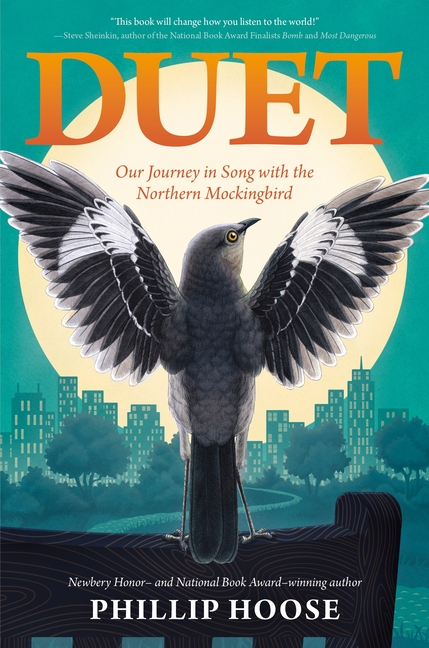Meet-the-Author Recording with Phillip Hoose
Duet: Our Journey in Song with the Northern Mockingbird |
Phillip Hoose introduces and shares some of the backstory for creating Duet: Our Journey in Song with the Northern Mockingbird.
Translate this transcript in the header View this transcript Dark mode on/off
Phillip Hoose: Hi, this is Philip Hoose, the author of Duet: Our Journey in Song with the Northern Mockingbird.
I was attracted to the mockingbird's song. Even when I was a kid, I was aware of this one bird that kept singing and it would repeat its phrases just once or twice and then go on to a new one and then go on to a new one. I wondered, how does it know all those songs? Why does it sing like that? I was just incredibly curious about mockingbirds when I was a kid and the curiosity extended into my adulthood and I decided I would write a book about it. It was a fascinating book to write and to research. Mockingbirds, they're the bird species that's been most tightly connected to human songs, myths, literature, entertainment, art, business, battle, science and yet it sort of goes under the radar when you think about the birds that have meant so much to this country, but I think it's meant every bit as much as eagles and turkeys and birds such as that. It has unique connection to human beings that make it really a compelling bird.
I mean, we have had stories and songs and there's one song, Listen to the Mockingbird "Listen to the Mockingbird, Listen to the Mockingbird." That song has been with us for well over a hundred years now. It's the same with literature, with stories, they're songs and poems and works of art that are really everywhere. That was what really surprised me was how much material there actually is. It turns out to be an incredibly popular bird but people kind of don't notice it in that way. It's the state bird of five different states. One reason for all this is that it's so adaptable. It can live in almost any environment and it can be found all throughout the United States and lower North America, so that if you wanted to pick a bird that would be fascinating to study and common and easy to find, you couldn't go wrong with the mockingbird.
I love birds and I want others to love birds too but I understand that there's a lot that competes for your attention these days. It's a noisy world, and I hope that the readers will fling open the windows and go outside and listen to the mockingbird's song.
This is Phillip Hoose with an excerpt from my new book, Duet: Our Journey and Song with the Northern Mockingbird. And this scene is from 1850 and it describes a visit to a market, an outdoor market in Philadelphia about that time.
Children dragged their parents past vendors and food stands and made their way to the caged birds. There they found cages stacked one on top of another. Inside, climbing the wires, were bright red cardinals and electric blue indigo buntings. Emerald green parrots used their powerful beaks and claws to hitch themselves along the wires of their cages. Youngsters seem to be magnetically attracted to the mockingbirds who sang almost without stopping. Clustering around the cages, children tried to get the mockers to imitate them. They peppered the bird sellers with questions such as "Why does it keep singing?" And "How does it know all those songs?" Many of the vendors knew very little about the birds they were offering for sale. They were products, nothing more or less. Typically, the vendor had paid a boy a pittance to dash across a lawn or a field to snatch a baby bird from a mockingbird nest. Many of the nestlings were blind and naked except for a thin coat of gray down.
The captured bird were placed into cages, fattened up for a few days, taught to imitate a few songs and taken to the bird stall at High Street Market. There, a singing adult mockingbird could fetch $50. That's what the vendor knew. He did his stumbling best to come up with answers while the kids kept hammering him with new questions. Their curiosity was endless. "What do you feed it?" "Can you teach it a song?" "How many songs does it know?" And then inevitably, "Please, father, mother, can we take it home? Please? Oh, thank you."
This Meet-the-Author Recording with Phillip Hoose was exclusively created in May 2022 by TeachingBooks with thanks to Macmillan.



